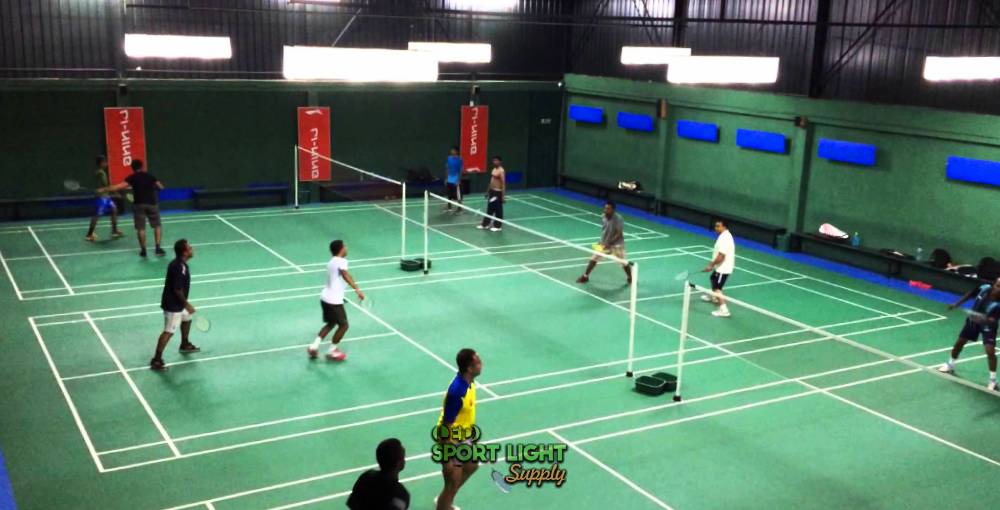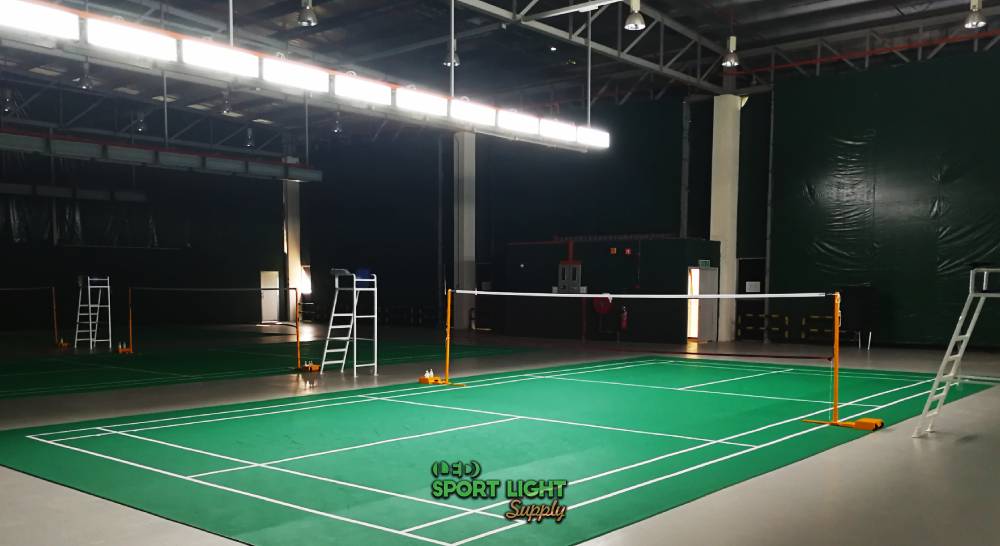With growing awareness about climate change and energy conservation, solar-powered lighting systems have become a viable alternative. These systems harness solar energy to power the lighting for badminton courts, offering a sustainable solution that reduces energy costs and environmental impact. As the demand for green technologies continues to rise, solar-powered lighting for sports facilities like badminton courts is becoming increasingly popular.
Table of Contents
ToggleSolar-powered lighting systems are highly efficient, as they rely on renewable energy from the sun rather than drawing power from the local grid. This reduces the demand for electricity, which can be especially beneficial for outdoor badminton courts that may otherwise require significant energy to remain lit during evening hours. By converting sunlight directly into electricity, solar-powered systems help reduce overall energy consumption. Moreover, the use of LED lights in combination with solar panels ensures that energy is used effectively, providing sufficient brightness with minimal waste. Over time, this leads to substantial energy savings, especially when compared to traditional lighting systems.
The financial benefits of solar-powered lighting systems are clear, especially in areas where electricity costs are high. While the initial installation cost of a solar-powered lighting system can be higher than that of traditional lighting, the long-term savings more than offset this expense. Once installed, solar systems have very low operational costs since they are powered by free sunlight. Maintenance costs are also lower, as solar-powered lighting systems have fewer components that require frequent upkeep. Batteries and solar panels may need occasional maintenance or replacement, but these costs are relatively low in comparison to the energy bills associated with conventional lighting. Over time, the return on investment becomes significant, making solar-powered lighting a cost-effective option for badminton courts and other sports facilities.

One of the most compelling reasons to adopt solar-powered lighting is its positive environmental impact. Traditional lighting systems, particularly those powered by fossil fuels, contribute to air pollution and greenhouse gas emissions. By switching to solar lighting, badminton courts can reduce their carbon footprint and contribute to a cleaner, more sustainable environment. Solar energy is renewable and does not produce harmful emissions during its generation or use. As a result, the widespread adoption of solar-powered lighting in sports facilities can help reduce the collective environmental impact of the sports industry. This transition aligns with broader efforts to combat climate change and promote sustainability across various sectors.
Solar-powered lighting systems offer a level of reliability and independence that traditional grid-powered systems cannot. In areas where the power grid is unreliable or where electricity supply is limited, solar-powered lighting offers a stable and dependable alternative. Since solar lighting systems are not connected to the grid, they are not subject to power outages or fluctuations in supply. This is particularly valuable in remote locations or during natural disasters, when access to the grid may be compromised. Solar lighting also reduces reliance on fossil fuels, contributing to energy independence. With solar panels and batteries storing energy, the system can function independently of local power sources, ensuring that the lights remain on whenever they are needed.
The durability of solar-powered lighting systems is another factor that makes them appealing. Solar panels, LED lights, and batteries are designed to withstand outdoor conditions for extended periods. With proper maintenance, solar-powered lighting systems can last for many years. Solar panels, in particular, have a long lifespan, often exceeding 25 years, while LED lights can last up to 50,000 hours or more. This longevity makes solar-powered lighting a reliable and cost-effective solution for sports facilities, as the need for replacements or repairs is minimal. Additionally, since solar systems do not rely on external power sources, there is less wear and tear on the components, further enhancing their longevity.

The location of the badminton court is a key factor in determining the effectiveness of a solar-powered lighting system. Solar panels rely on sunlight to generate electricity, so it is important to assess how much sunlight the location receives throughout the day. Areas with more direct sunlight will produce more energy, ensuring that the system has enough power to meet the lighting needs of the court. Conversely, courts located in shaded areas or regions with frequent cloud cover may need larger or more efficient solar panels to compensate for reduced sunlight. A site assessment is crucial to determining the optimal placement of the solar panels to maximize energy production.
The size of the badminton court plays a role in determining how many solar panels, batteries, and lights are required for adequate illumination. A larger court may require more lights and a larger energy storage capacity to ensure that the entire area is well-lit during evening play. The number of LED lights needed will depend on the lighting standards for badminton courts, which vary by location and competition level. It is important to balance the number of lights with the available energy from the solar panels to ensure that the system can provide consistent and reliable lighting throughout the night.
Court Size and Lighting Requirements
| Court Size (m²) | Lights Required (Units) | Solar Panel Area (m²) | Battery Capacity (Ah) |
|---|---|---|---|
| Small (10×5) | 4-6 | 10-12 | 50-100 |
| Medium (20×10) | 8-12 | 20-25 | 150-250 |
| Large (30×15) | 12-16 | 30-35 | 250-400 |
This table gives an estimate of the number of lights, solar panel area, and battery capacity needed for different court sizes.
Achieving the right level of brightness is essential for any sports court, including badminton courts. The lighting system must provide enough illumination to ensure that players can see the shuttlecock clearly and move around the court safely. However, brightness alone is not enough; uniformity is also important. The lighting must be evenly distributed across the court to avoid shadows or overly bright spots that could affect visibility. LED lights are often used in solar-powered lighting systems because they provide high-quality, uniform illumination. However, achieving the right balance of brightness and uniformity requires careful planning and design.
Weather conditions are another important consideration when installing solar-powered lighting systems. Since the system will be exposed to outdoor elements, it must be designed to withstand various weather conditions, including rain, wind, snow, and extreme temperatures. The solar panels, batteries, and lights must be weatherproof and able to function reliably in diverse climates. Additionally, the installation process should ensure that the system is properly sealed and protected from potential damage caused by weather events. By considering the local climate during the design and installation stages, it is possible to ensure that the solar-powered lighting system remains operational and efficient throughout the year.
Integrating all components of a solar-powered lighting system is crucial to its overall effectiveness. The solar panels, batteries, LED lights, and controller systems must all work together seamlessly to provide reliable and energy-efficient lighting. The integration process involves selecting compatible components, ensuring proper wiring, and configuring the controller systems to optimize energy use. It is important to work with experienced professionals who understand the technical aspects of solar-powered lighting systems to ensure a smooth installation process. Proper integration helps maximize the performance of the system, minimizing energy wastage and ensuring that the lights function as needed.

The upfront cost of installing a solar-powered lighting system can be higher than that of traditional lighting systems. This is due to the cost of purchasing and installing solar panels, batteries, and LED lights. However, this initial investment is offset over time by the savings on energy bills and lower maintenance costs. Financial incentives, such as tax rebates or grants, may be available in some regions to help reduce the cost of installation. In addition, as solar technology continues to improve, the cost of solar panels and related components is expected to decrease, making solar lighting systems more accessible to a wider range of sports facilities.
One of the challenges of solar-powered lighting systems is ensuring that there is enough energy storage capacity to meet the lighting needs of the badminton court. On days when there is limited sunlight, such as during overcast weather or in the winter months, the system may not generate enough electricity to power the lights for an entire evening. To address this issue, it is important to size the battery system appropriately, ensuring that it can store enough energy to compensate for periods of low sunlight. Advanced battery technologies, such as lithium-ion batteries, offer higher storage capacities and longer lifespans, helping to improve the reliability of solar-powered lighting systems.
While solar-powered lighting systems generally require less maintenance than traditional lighting systems, they are not completely maintenance-free. Solar panels need to be cleaned regularly to remove dirt and debris that can reduce their efficiency. Batteries may need to be replaced every few years, depending on their type and usage. Additionally, the wiring and lights may need occasional repairs or replacements. However, the overall maintenance costs are still relatively low compared to traditional lighting systems, and the long lifespan of solar-powered components helps minimize the frequency of maintenance.
Weather conditions can pose a challenge for solar-powered lighting systems, especially in regions that experience frequent changes in weather. Periods of heavy rain or snow can reduce the amount of sunlight available for the solar panels, leading to lower energy production. To mitigate this issue, solar-powered systems can be designed with larger energy storage capacities or hybrid systems that combine solar power with other renewable energy sources. This ensures that the lighting system remains operational even during periods of unfavorable weather.
Solar-powered lighting systems provide a sustainable and cost-effective solution for outdoor badminton courts. They offer a range of benefits, including energy efficiency, reduced operational costs, and a smaller environmental footprint. By harnessing the power of the sun, these systems reduce the need for grid electricity, which lowers both energy consumption and costs. As the technology continues to evolve, solar lighting systems are becoming increasingly reliable, durable, and affordable. The transition to solar lighting for badminton courts, as well as other sports facilities, contributes to a greener future and supports the global movement toward renewable energy. With ongoing advancements in energy storage, smart technologies, and hybrid systems, the potential for solar-powered lighting to revolutionize outdoor sports facilities is vast, making it a viable and desirable option for a wide range of venues worldwide.
Drop us a line to receive a free lighting design